St. Francis, born in 1181 to a wealthy silk merchant and his wife, was definitely no saint to begin with. He partied and drank with his friends and generally got into trouble. Even after being imprisoned for a year during the war between Assisi and Perugia, he returned to his extravagant ways. But then, the story goes, he met a 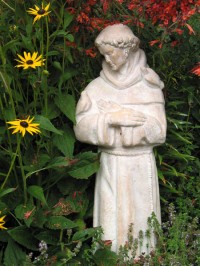 beggar and was so struck by the misery he saw that he gave all his money away. He continued to give, to his father’s annoyance.
beggar and was so struck by the misery he saw that he gave all his money away. He continued to give, to his father’s annoyance.
The big transformation came when Francis fell seriously ill and had a spiritual vision that changed his life to one of poverty and peace. It also changed Assisi, an Umbrian town on the slope of Mt. Subasio. Today, tourists and pilgrims by the millions, from all nations, come to see the medieval birthplace of Italy’s patron saint.
T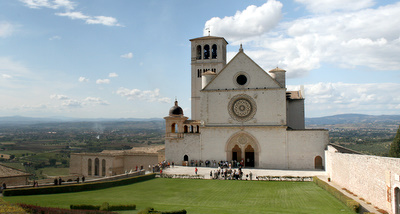 he main attraction is the immense Basilica di San Francesco, where you can wander among chapels and cloisters and marvel at stunning paintings and frescoes. St. Francis’ tomb is here, with a few relics – a tattered tunic, a bit of parchment. Every few minutes you hear an amplified male voice saying, “Silenzio!” and the murmuring crowd quiets, temporarily.
he main attraction is the immense Basilica di San Francesco, where you can wander among chapels and cloisters and marvel at stunning paintings and frescoes. St. Francis’ tomb is here, with a few relics – a tattered tunic, a bit of parchment. Every few minutes you hear an amplified male voice saying, “Silenzio!” and the murmuring crowd quiets, temporarily.
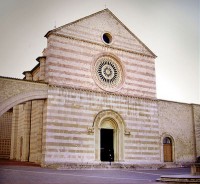 Assisi has many more religious sites than the basilica. The red-striped, 13th-century church of St. Clare holds the tomb and lily-holding effigy of St. Clare, one of St. Francis’ early followers. On the slope nearby is an olive grove; the St. Clare nuns have been growing olives here for hundreds of years.
Assisi has many more religious sites than the basilica. The red-striped, 13th-century church of St. Clare holds the tomb and lily-holding effigy of St. Clare, one of St. Francis’ early followers. On the slope nearby is an olive grove; the St. Clare nuns have been growing olives here for hundreds of years.
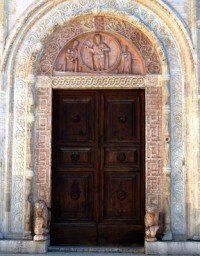 In the historic Romanesque Church of San Rufino (St. Francis and St. Clare were baptized here), you can see even earlier churches, and what may be an early Roman temple. Glass floors reveal the old foundations. Another pre-Christian temple is the 2,000-year-old Temple of Minerva. The classical façade stands, while the interior is a 17th century remake. Near it is the Forum, one of Assisi’s lesser-known sites, and in my view not to be missed. A tunnel takes you into 1st-century Roman ruins, directly under the piazza. This was once the ancient road of Assisium, leading to Temple Minerva. Now it ends at a brick wall.
In the historic Romanesque Church of San Rufino (St. Francis and St. Clare were baptized here), you can see even earlier churches, and what may be an early Roman temple. Glass floors reveal the old foundations. Another pre-Christian temple is the 2,000-year-old Temple of Minerva. The classical façade stands, while the interior is a 17th century remake. Near it is the Forum, one of Assisi’s lesser-known sites, and in my view not to be missed. A tunnel takes you into 1st-century Roman ruins, directly under the piazza. This was once the ancient road of Assisium, leading to Temple Minerva. Now it ends at a brick wall.
There are more interesting places, but even pilgrims have to eat, sleep and buy souvenirs. The townsfolk oblige with numerous hotels and restaurants 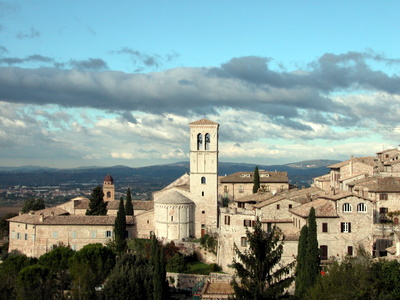 and dozens of souvenir shops along the cobblestoned streets. Hotel Fontebella has a central location and wide views (from some rooms) of the lovely countryside. Service is swift and breakfast simple but good – tasty European yogurt, croissants, fruit and coffee. Hotel Ideale also offers great views, nice gardens, and small but pleasant rooms. Hotel Umbra, family-owned for a century, has a lovely patio garden, comfortable guestrooms, and is perfectly located on a small street near the main square.
and dozens of souvenir shops along the cobblestoned streets. Hotel Fontebella has a central location and wide views (from some rooms) of the lovely countryside. Service is swift and breakfast simple but good – tasty European yogurt, croissants, fruit and coffee. Hotel Ideale also offers great views, nice gardens, and small but pleasant rooms. Hotel Umbra, family-owned for a century, has a lovely patio garden, comfortable guestrooms, and is perfectly located on a small street near the main square.
At mealtime we liked Taverna dei Consoli for its chicken with rosemary and pasta with mushrooms, eaten at a table on a covered terrace. Other highly recommended restaurants are Trattoria della Fortezza and Trattoria Pallotta – both excellent. And one evening we bought sandwiches, olives and chocolate and ate in our hotel room, watching swallows dip and fly over the roofs while lightning flashed on the far horizon.


Comments